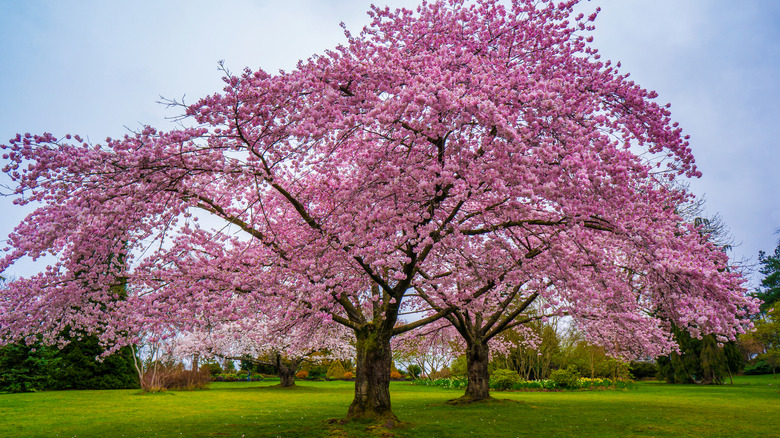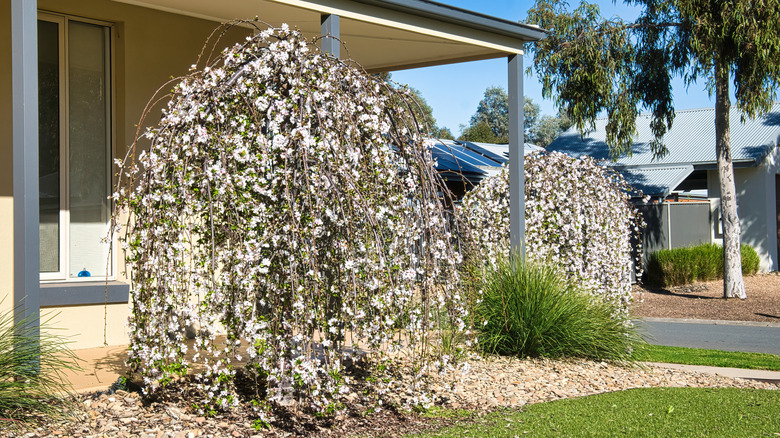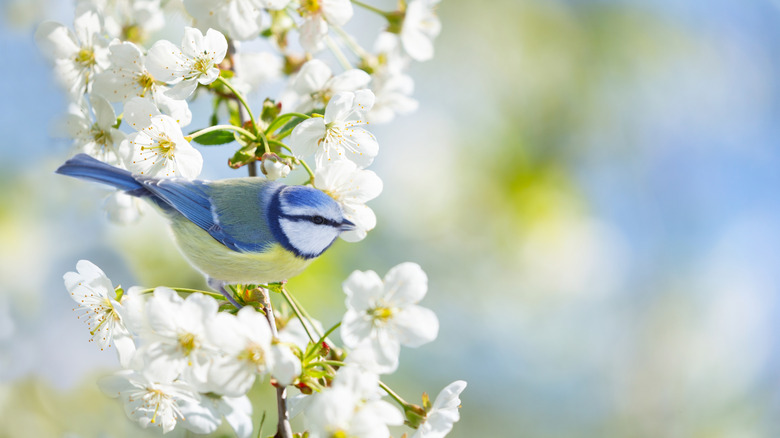The Best Growing Conditions For A Thriving Cherry Blossom Tree
Every plant deserves to thrive, but it almost seems like a waste to give a stunning ornamental cherry blossom tree (Prunus serrulata) anything less than the ideal conditions to flourish. These specimen trees are often given a point of pride in a garden, so you will want to ensure they get what they need to put on the best cherry blossom show possible. While there is plenty you should know before planting a cherry blossom tree, the tree's overall needs are relatively simple: a sunny spot, the right soil, and room to grow. However, cherry blossom trees come in many varieties, so we're going to make a blanket statement now: check the details of the tree you want to ensure it's right for your yard.
Selecting the right variety starts with picking the best one for your climate. Typically, cherry blossom trees are hardy from USDA Zones 5 to 8 but they do differ, so ensure the one you want will work for your area. Additionally, these gorgeous trees generally thrive in full sun, though some can take a bit of shade. Typically, however, a sunny spot in well-drained, rich soil that provides protection from the wind is ideal for most cherry blossom trees. Remember, this tree may need up to 20 feet of space in all directions to grow to its full potential.
The ideal conditions for cherry blossom trees
You've found the perfect tree for that sunny spot in your yard. Now what? First, ensure the area is big enough. Take the location of your home, other trees, and powerlines into consideration when locating your tree. If you don't have 20 feet of clearance for your cherry blossom tree, don't worry, smaller varieties exist. Do your homework and find the size that's right for your needs. If you can, find a sheltered spot to plant the tree, as this helps protect the fragile blooms from harsh winds.
To ensure the best start, plant your new tree with a mix of half compost and half soil. Give it a deep watering upon planting. It can be hard to know if you are watering a newly planted tree enough, but generally, young trees need regular watering until they are established. Still, keep in mind, standing water is the cherry blossom's enemy so make sure to steer clear of soggy areas and that your soil is draining properly. To make matters more complicated, they are not tolerant of drought, so getting their soil moisture right is key.
While these trees are stunning in spring, they quickly lose their blooms, so you will want to ensure you have other interest in your landscape throughout the season. Cherry blossom trees are traditionally used in Japanese garden design, and tend to work well with evergreens or azaleas (Rhododendron). Hostas (Hosta plantaginea), bleeding heart (Dicentra spectabilis), and spring bulbs can also make great companions for flowering cherry blossom trees.
A frosty danger to your cherry blossoms
Giving these relatively short-lived trees every advantage is essential, as they are susceptible to a number of diseases — like fireblight to powdery mildew — as well as pests, including but not limited to aphids, tent caterpillars, and leafhoppers. However, one of the biggest threats to your tree's yearly bloom is the weather. We all get excited at the sight of buds on the trees after a long winter, but if your cherry blossom buds show up too early, you may have a problem on your hands. So, if you find yourself enjoying a few unseasonably warm days before the danger of frost has passed, you may need to provide your trees with a little extra protection when the weather turns cold again. Frankly, this could happen even if you have an unexpected late frost.
At 27 degrees Fahrenheit, cherry blossom tree buds can be damaged by the cold. Just a few degrees lower and almost all of them can be compromised. So, if a warm spell causes your cherry blossoms to start budding early, and the weatherman predicts a frost, get your burlap out. Wrap your trees lightly to protect them from the weather. Don't have a bunch of burlap hanging around? An old sheet or other fabric will work, but keep in mind that there are some garden hacks that won't actually protect your plants from frost – like using a plastic tarp. Additionally, hardwood or cypress mulch will also help the tree thrive year-round.


